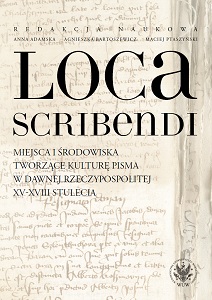Małomiasteczkowy locus scribendi w późnym średniowieczu. Przykład Radziejowa
A small town as locus scribendi in the Late Middle Ages. The example of Radziejów
Author(s): Katarzyna Warda
Subject(s): Middle Ages, 6th to 12th Centuries, 13th to 14th Centuries, 15th Century, 16th Century, 17th Century, 18th Century
Published by: Wydawnictwa Uniwersytetu Warszawskiego
Keywords: writing environment; consistory; notary; writer; writing; office; books; XV-XVIII centuries; writing culture
Summary/Abstract: The topic of the article is the organisation of work in the municipal chancery of Radziejów, a very small town in Cuyavia, in the northern part of late medieval Poland. The records of the local bench and the council registers from 1445–1455 were carefully investigated to this end. As creators of the urban locus scribendi, first the municipal officials and scribes should be mentioned. In the short period of ten years investigated here, 26 persons were connected to the council, while 49 others were involved in work for the urban bench. Palaeographical analysis shows that most entries into both series of town books were made by a single person; accidental hands are scarce. The bench and the council of Radziejów employed the same scribe, and maybe even employed a shared chancery. It is impossible, however, to say where such a joint scribal office might have been situated. The quality of the Latin in the records, the way the records were kept, and the correctness of the legal formulary allows us to judge the professional skills of Radziejów scribes favourably. The types of matter recorded in the town books, their number and frequency, shows that most cases recorded in the council’s registers concerned debts. The bench tried more varied legal matters; yet its records register mainly trade in real estate and regulations concerning ownership. Comparison with other towns shows that the contents of the urban books was hardly extraordinary for late medieval Poland. Prosopographical analysis of the chancery’s clients (their gender, social status, dignities, profession, their role in the cases as described in the town books, and the frequency of their appearances before the council and the bench), shows the profile of a typical client of a small town’s locus scribendi. The average client was a male, usually in possession of the citizenship. Most often he appeared before the bench court on his own, arranging simple matters. He did not belong to the local elites but was a ‘normal’ town-dweller. In ten years, in a settlement of c. 1,000 inhabitants, almost 450 persons came in touch with the chancery. Considering that 75 other persons served as councillors or aldermen, we must conclude that the number of people using the municipal scribal office was really large. Although in Radziejów other loca scribendi were active as well (the magistrate, the terrestrial court, a monastery, and the parish church), for town-dwellers the chancery was most important.
- Page Range: 63-99
- Page Count: 38
- Publication Year: 2017
- Language: Polish
- Content File-PDF

